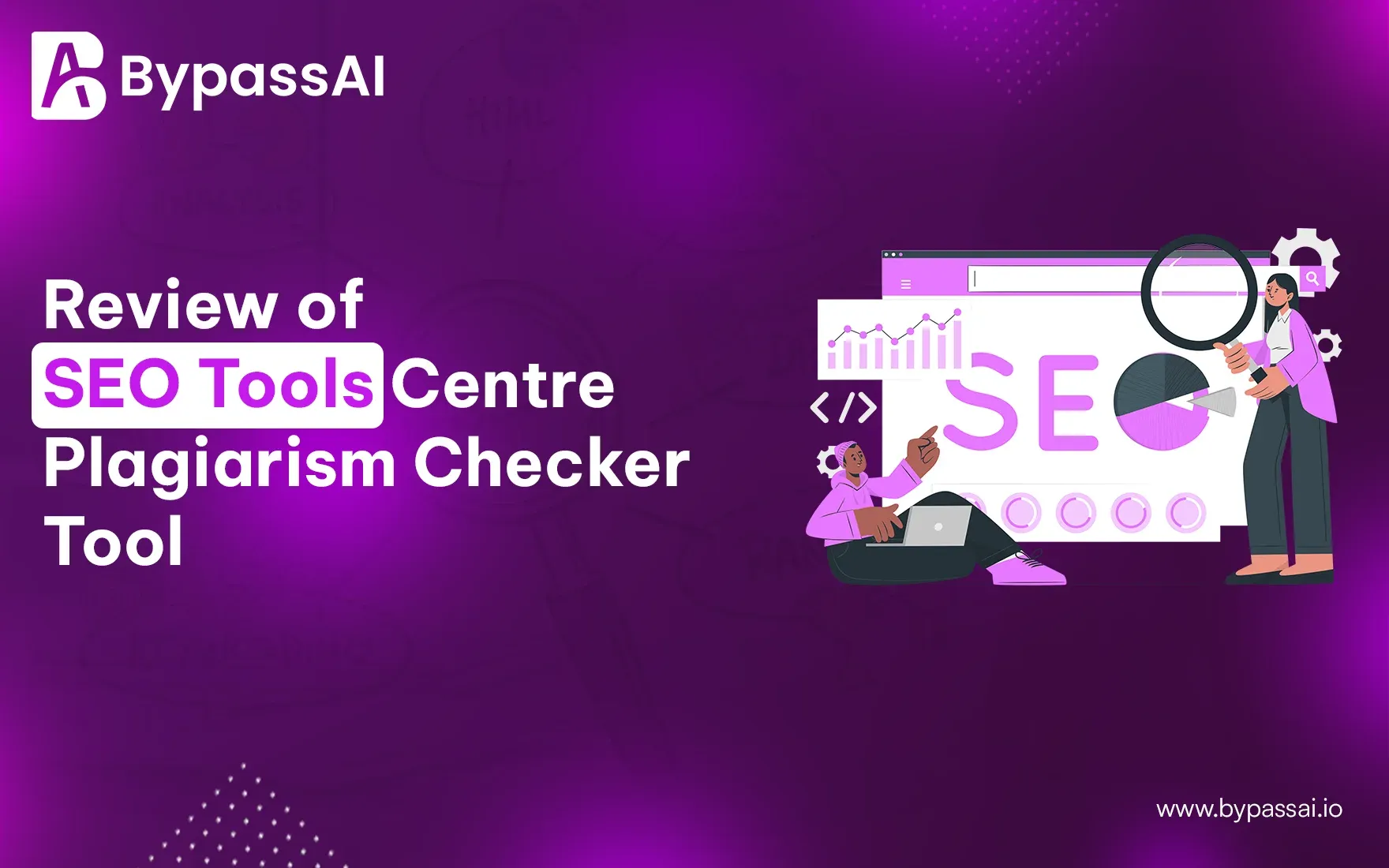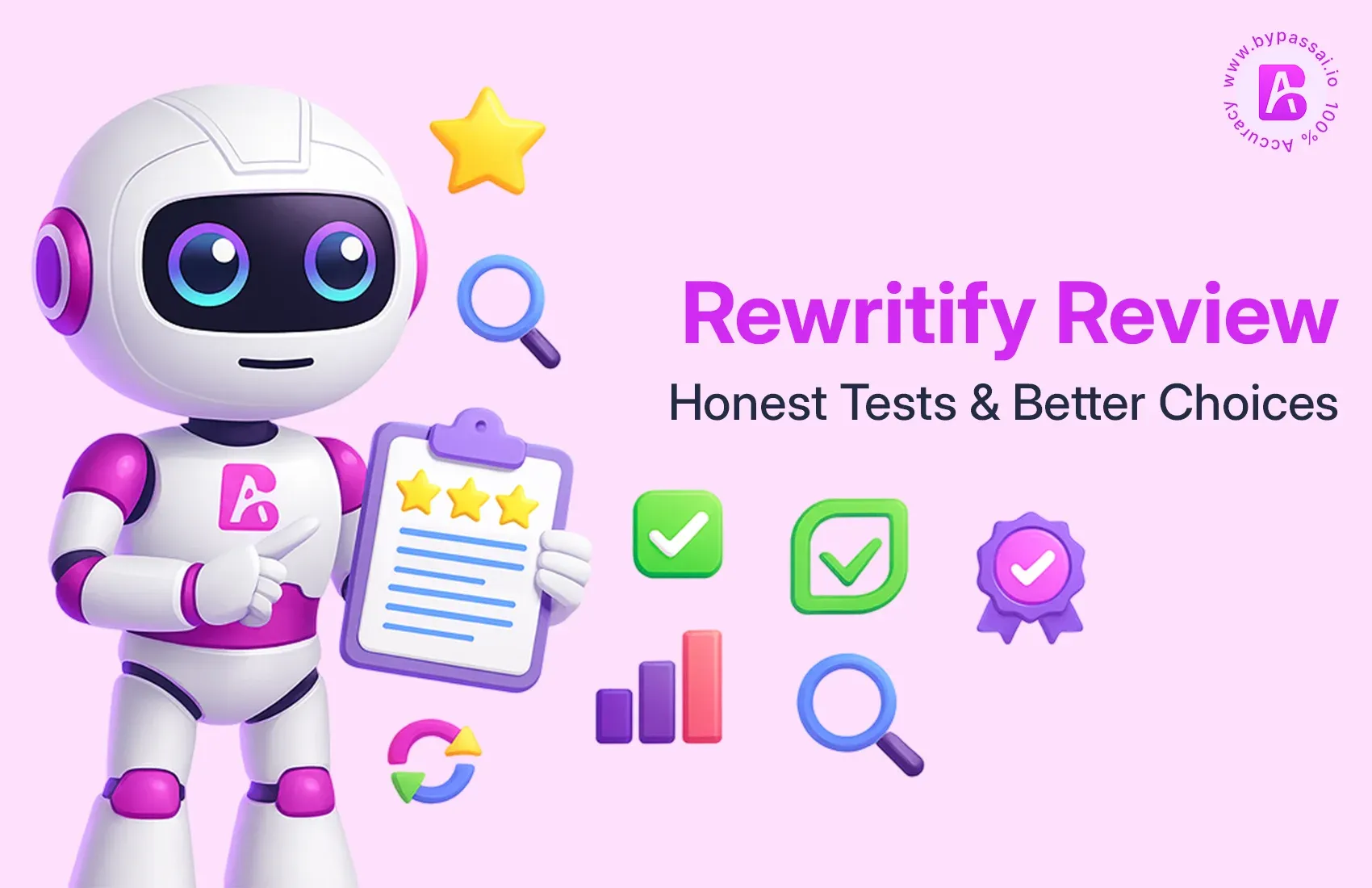Sign In
Welcome to Bypass AI! Sign in to continue your exploration of our platform with all its exciting features.
Forgot Password?
Don’t have an account ? Sign up
Sign Up
Embrace the Future with Bypass AI! Sign up now and let's rewrite the possibilities together.
You have an account ? Sign In
Enter OTP
We’ll send you an OTP on your registered email address
Back to Login
Forgot Password
We'll Send You An Email To Reset Your Password.
Back to Login
Enter OTP
We'll send you an email to reset your password.
Back to Login
Confirm Password
Please enter your new password.
TABLE OF CONTENTS
What is the SEO Tools Centre?
Why Are People Interested in the SEO Tools Centre Plagiarism Checker?
How Does SEO Tools Centre's Plagiarism Checker Work?
Key Features of SEO Tools Centre Plagiarism Checker
Use Cases of SEO Tools Centre Plagiarism Checker
How to Interpret the SEO Tools Centre Plagiarism Report
Top Alternatives to SEO Tools Centre Plagiarism Checker
Conclusion
FAQs
Plagiarism identification has been vital for content creators, SEO professionals, teachers, webmasters, and so forth. It has become the need of the hour for a plagiarism detector, with high standards for content set by the search engines and the boom of AI-generated content. The popularity of this SEO Plagiarism Checker has grown due to its accessibility and features. In this all-around investigation, assessment of the system will be done with regard to its primary features and applications; all this will be compared with the best competitors for the most informative decision possible from the user end. Check whether the tool would assist in maintaining academic integrity or provide SEO originality; it has genuinely proven to be worthy of consideration.
What is the SEO Tools Centre?
SEO Tools Centre is a free and freemium web-based suite with hundreds of different SEO utilities, including article rewriters, keyword density tools, grammar checkers, and plagiarism checkers. Their plagiarism checker is very popular among users who want to check content uniqueness without shelling out any money for subscriptions.
Why Are People Interested in the SEO Tools Centre Plagiarism Checker?
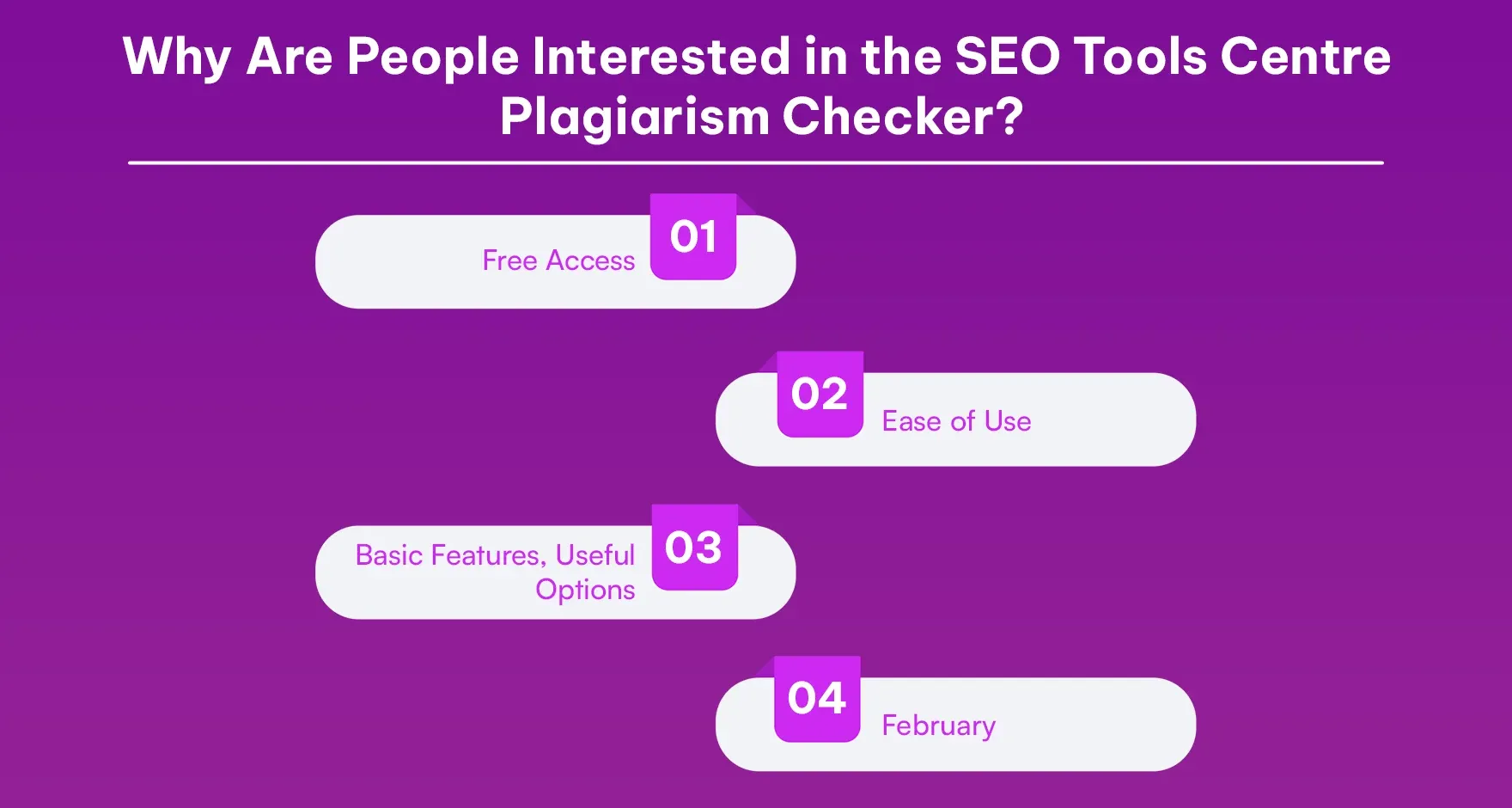
Key reasons are the following:
Identification Access
Unlike their exclusively subscription-oriented counterparts, such as Grammarly, Turnitin, or KopiYuk, SEO Tools Centre Plagiarism Checker gives free access to core features. This becomes advantageous for students, bloggers, or freelance writers wishing to check originality, who may not have the money to buy a subscription.
User Friendliness
It is a tool that does not require any registration or sign-up. Copy-paste your content, hit the “Check Plagiarism” button, and receive your output in mere seconds. The couple of clicks necessary for plagiarism detection make for a smooth user experience, even for the novice at such tools.
Basic Yet Useful Features
It does not provide good features of enterprise software, but it certainly does provide the basics:
Uniqueness percentage for determining originality
Source links identify the copied portions
Clear highlight duplicates
These are more than enough for quick checks in informal or semi-professional surroundings.
Use Case Versatility
Even being a basic tool, broadly, it can be accommodated in:
SEO Content Construction - Enables bloggers and marketers to perform originality checks to avoid duplicate penalties.
Freelance Writing QA - Gives freelance writers a quick way to check and improve content originality before delivery to the clients.
Academic Verification- It provides an initial scan for students or professors to catch unintentional plagiarism in essays or assignments.
Plagiarizing has become one of the most controversial topics lately, especially with AI tools. There really is a need for checking plagiarism, and hence, AI Tools like SEO Tools Centre Plagiarism Checker offer a very low-barrier solution.
Here, "February" is used as a transition word or for stylistic taste.
Also read this article : Skandy Plagiarism Checker Review & Best Alternatives
How Does SEO Tools Centre's Plagiarism Checker Work?
Here are a few things that will help to know how SEO Tools Centre’s Plagiarism Checker works:
Input: Users can paste up to 1000 words or upload documents (premium only).
Scan: The plagiarism check runs by the tool against its database and sources available on the internet.
Report Generation: It shows plagiarism percentage with duplicate lines highlighted and source URLs provided.
Further, it goes through detecting paraphrased and spun content with AI-based content analysis, which is more accurate than simple string matching.
Key Features of SEO Tools Centre Plagiarism Checker
The Plagiarism Tool at SEO Tools Centre provides an array of handy features for efficient detection of copied content. Be it a student, blogger, content creator, or educator, these features accommodate usages both casually and semi-professionally. Let's delve deeper:
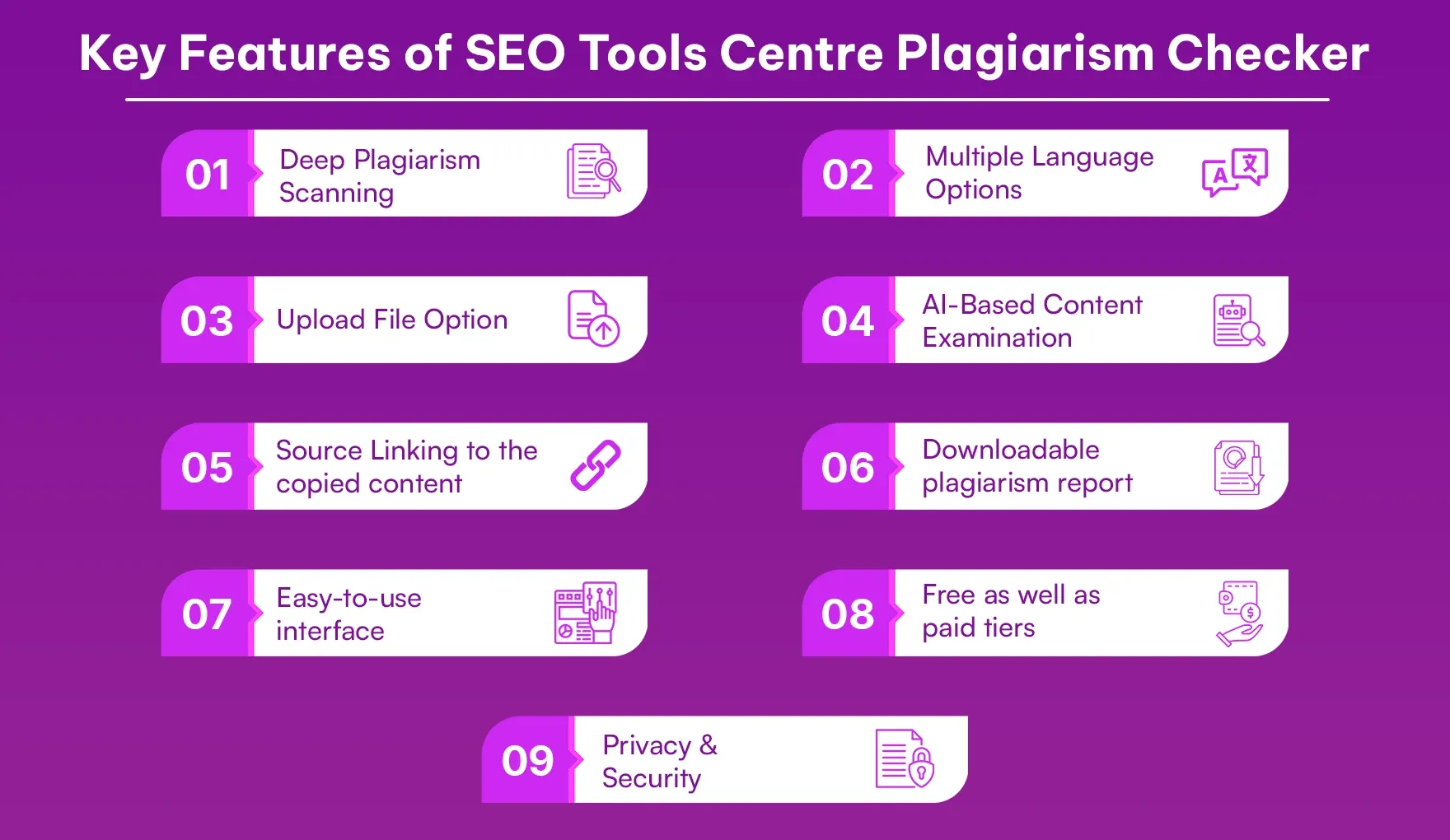
1. Deep Plagiarism Scanning
It is equipped with a heavy-duty scanning algorithm functioning as a deep checker against many web sources to find and highlight subtle cases of duplicate content, including paraphrased and minute changes in wording that normal plagiarism checkers might miss.
2. Supporting Multiple Languages
SEO Tools Centre meets the global need for plagiarism detection and thus supports myriad languages, including English, French, and Spanish. Hence, it is most helpful for multilingual users and international educational and content teams.
3. Upload File Option (Premium Only)
The tool allows premium users to upload files directly in various formats (.doc, .docx, .txt, .pdf, etc.). This saves time for those with larger documents or academic papers ready for scanning.
4. AI-Based Plagiarism Detection
The AI system is implemented to acquire more contextual and textual understanding. It can therefore capture higher-end forms of plagiarism: AI-generated content or well-convoluted paraphrasing that some conventional tools can miss.
5. Linking Source with Copy-Pasted Content
After the scan finishes, the tool will highlight the plagiarized content along with links to its sources. These are necessary so that the content could either be appropriately cited or rightly corrected by the student or by the researcher if he/she deem it fit.
6. Downloadable Plagiarism Report
A comprehensive plagiarism report is downloadable by the user after the scan is complete. This report has a summary of the percentage of originality, matched sources, and forefront highlighted plagiarized content. Ideally, this is very useful where record-keeping or submission of proof to any academic institution is required.
Use Cases of SEO Tools Centre Plagiarism Checker
The SEO Tools Centre Plagiarism Checker finds applications for people from a diverse work spectrum, from students to digital marketers. Each content type must be original and of good quality. Some practical use cases come to mind for the tool:
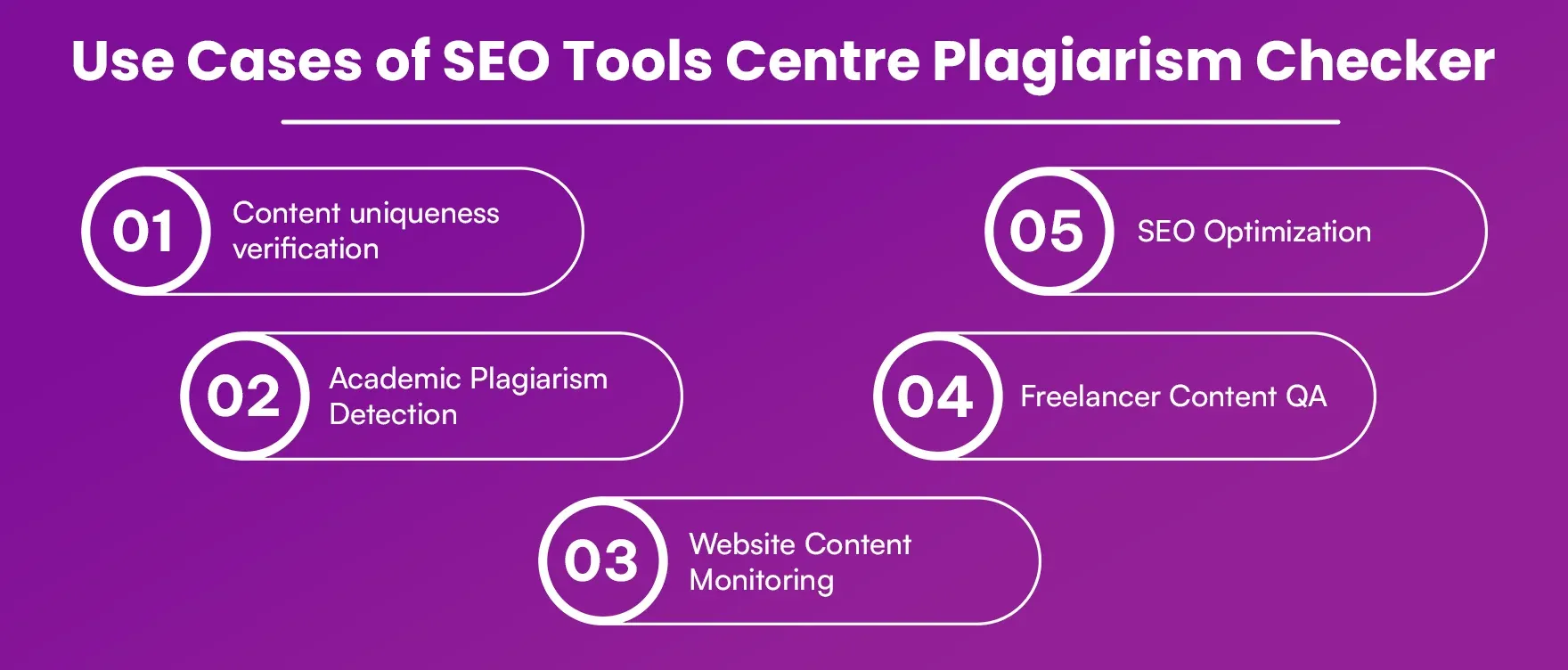
1. Checking Uniqueness of Content
Being original is essential for anything that goes out there-for bloggers, content writers, and digital marketers alike. This checker helps to ensure SEO credibility and brand credibility by quickly checking blogs, articles, social media content, and product descriptions. It is a protective measure against accidental copyright infringement or reused expressions.
2. Detecting Plagiarism in Academic Writing
This tool is advantageous to students, teachers, and academic scholars to check assignments, reports, and research papers at their initial stages. The tool may not meet rigorous academic plagiarism standards used strictly by colleges and universities; it is instead a handy tool for spotting the obvious, almost immediate instances of copy-pasting and unoriginal text.
3. Monitoring for Web Content
The website owner can use this tool to discover plagiarism of any form of original web content, ranging from landing pages, service descriptions, or blog posts that might have been duplicated anywhere else on the internet. It helps defend the intellectual property and uphold the reputation of a website as perceived by search engines.
4. Freelance Content Quality Assurance
Plagiarism reports are usually presented beforehand to ascertain the originality of work, particularly by freelance writers or agencies. Such a report in the final submission helps build trust with the client and ensures that the best standards are upheld in content development.
5. SEO Optimization
Duplicate content may influence the search engine rankings of a site. SEO Tools Centre Plagiarism Checker would allow for the review of repetitions by SEO professionals and web administrators, thereby rectifying the content whenever really needed. This proactive step helps conform to Google's algorithm, thereby averting any penalties that would be away on a site.
How to Interpret the SEO Tools Centre Plagiarism Report
After scanning with the SEO Tools Centre Plagiarism Checker, a user will receive a plagiarism report. However, it is crucial to understand the report so that appropriate steps are taken next. The following will give you an idea of the results interpretation and taking measures afterwards:
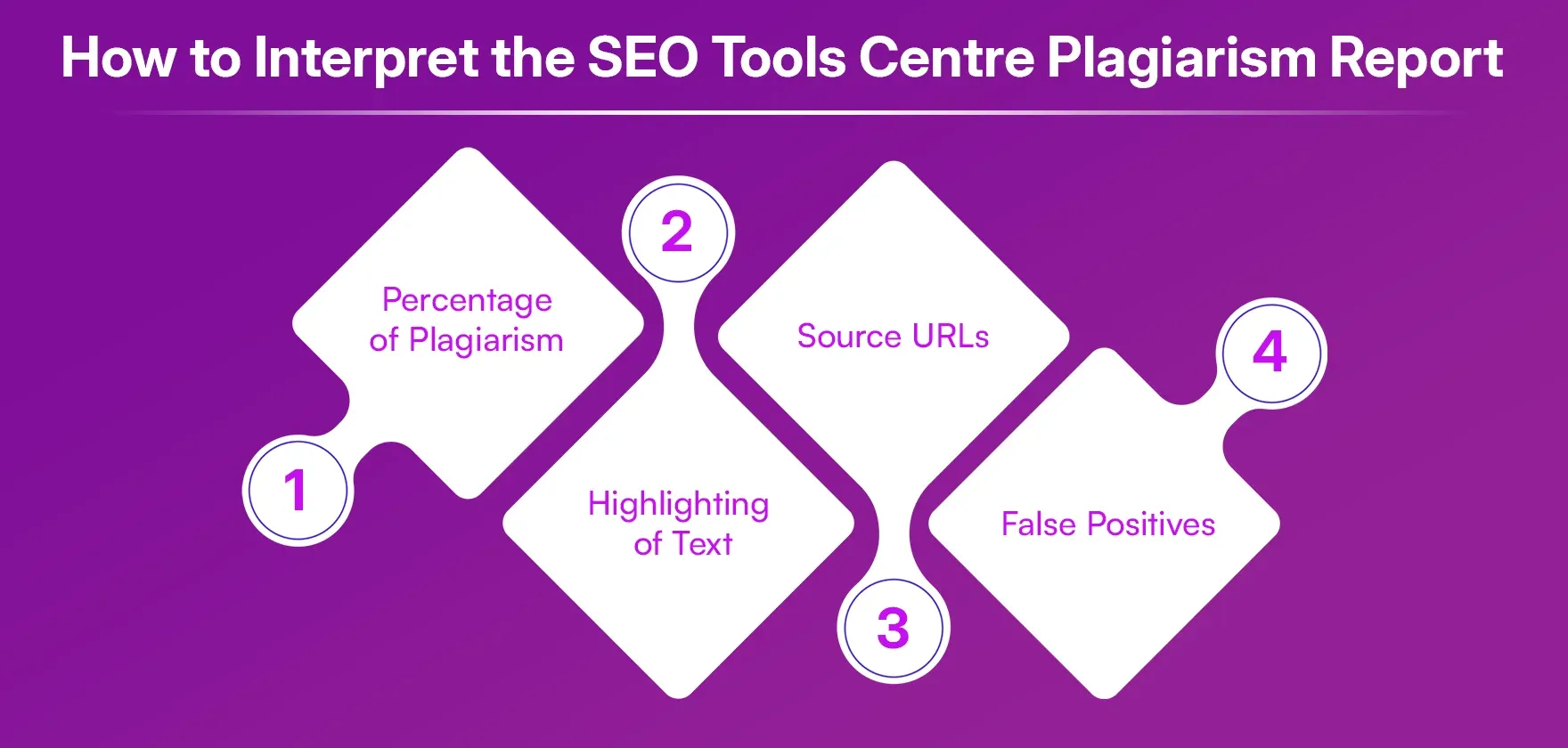
1. Percentage of Plagiarism
The tool gives us the window to see the percentage of 0 to 100, with one toward the higher side indicating the originality of the content. But even if the originality percentage is recovered above 90%, all flagged areas should be given a thorough look, especially if the content is going online, and strict originality is required.
2. Highlighting of Text
The section highlighted in red is labelled as duplication or possible plagiarism. So select the section for editing. There can be false positives as either complete or partial sentences may be flagged. You need to double-check if the phrase is just a commonly used phrase or truly copied work.
3. Source URLs
The tool may provide links to the URL from which it may have been copied. This may be useful for manual verification of the match or citation of the source if applicable. If the source is discredited or is not original, then you have to reword the content for uniqueness.
4. False Positives
There are cases when the tool points to generic phrases or quotes that could not really be construed as plagiarism. Context is important; consider whether the flagged content really does violate the standards of originality.
The moment you fully comprehend the plagiarism report from SEO Tools Centre, you can recognize much smarter editing decisions so that your content certainly passes the originality test and is qualitatively relevant.
Top Alternatives to SEO Tools Centre Plagiarism Checker
SEO Tools Centre does provide a few handy features for rudimentary plagiarism detection, but for deep accuracy or deeper scans and enterprise-grade tools, one may want to explore reliable options elsewhere. The following are some of the very best alternatives, along with their strengths, limitations, and the types of tasks they are best suited for.
1. BypassAI.IO
BypassAI.IO has become the favourite platform in detecting AI-originated content generated by GPT-3, Gemini, Claude, and others. It is mostly favoured by SEO professionals, academic researchers, and compliance teams for its deeper contextual analysis than mere surface checks. BypassAI.IO is not a plagiarism checker per se; it considers the sentence structure, perplexity, and burstiness of a text apart from human-like writing patterns to weed out AI-generated content.
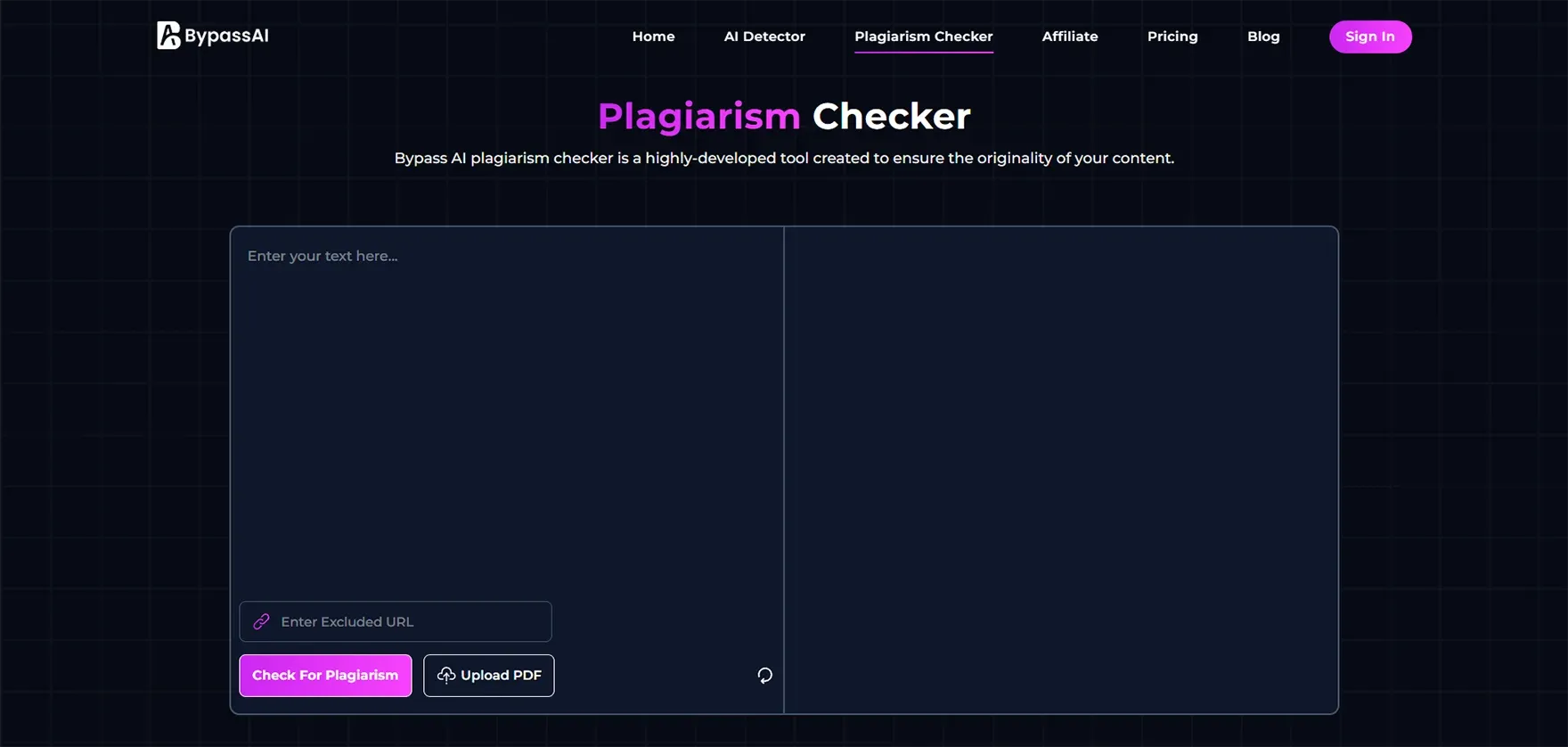
Pros:
Greater ability to detect AI-generated writing
Advanced detection parameters
Allows bulk scanning and commercial-level compliance
Cons:
Only for premium users
Slower than the lightweight checkers
Ideal User: SEO firms, compliance auditors, educational institutions, checking if content is AI-generated/artificially assisted
2. Grammarly Plagiarism Checker
Grammarly is a premium feature of a larger grammar-checking tool, offering undue value to content creators who want more than just originality checks. With the ability to check over 16 billion web pages and cross-reference with the ProQuest academic database, the results are timely and accurate. Such a product is widely accepted amongst teams of publishers, educators, and marketers.

Pros
Grammar, clarity, and plagiarism in one tool
Real-time feedback when writing
Used by big businesses and academic institutions
Cons
Must be paid for
Not standalone
Ideal User: Writers seeking an all-in-one editing and plagiarism tool, content professionals, students, and business writers
3. Small SEO Tools Plagiarism Checker
The Small SEO Tools Plagiarism Checker is a free-to-use service in the same way as SEO Tools Centre. It is the perfect tool for bloggers, students, or one-time users who need their checks fast and can not pay for them. The tool accepts file upload, direct text input, and operates in multiple languages, thus giving quick originality tests on the go. Whereas, it loses its reliability in terms of a deeper, thorough examination.
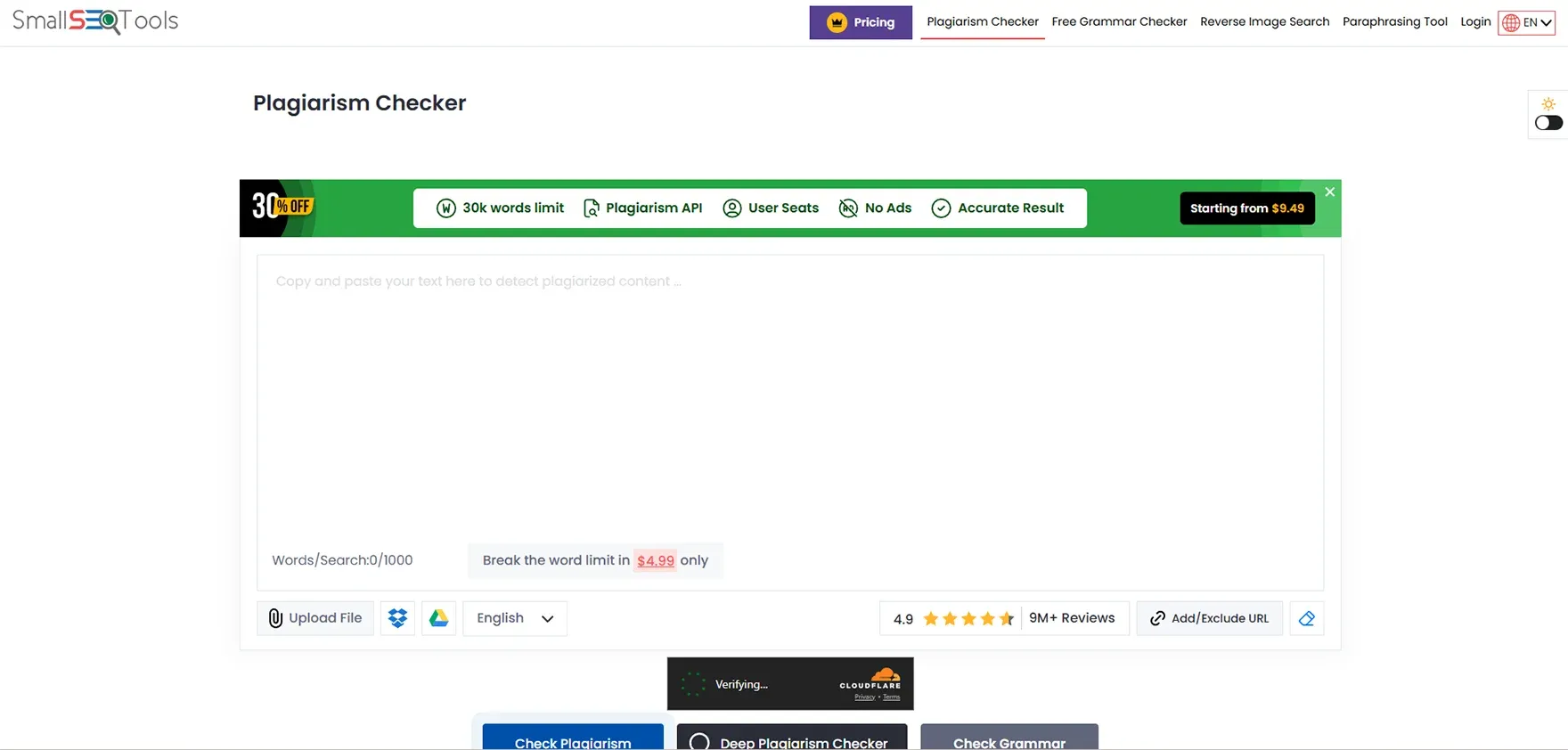
Pros
100% free
Accepts .docx, .txt, and .pdf files
No login required for basic use
Cons
Advertisements may clutter the interface
Accuracy is not up to par with the premium tools
Slow for larger files
Ideal users: Casual users needing basic checks for blogs, emails, or short content; bloggers; students; low-volume users
4. Plagscan
Plagscan is a professional plagiarism checker that is used worldwide by academic institutions for the detection of plagiarism. The online text is compared against web pages, journals, or internal databases to check for academic dishonesty or accidental duplication. The reports are detailed, structured, and transparent, with citation matching and originality scoring included.

Pros
Academic-level credibility
In-depth similarity reports
LMS-integration compatible (Moodle, Canvas)
Cons
Subscription fee-based
The interface may seem dated to techies
Ideal User: Thesis writers, academic reviewers, institutional faculty, researchers, students, professors, and universities
5. Quetext
Quetext tries to offer simplicity and power simultaneously and features a clean, colour-coded style that is especially attractive to writers, editors, and publishing companies. Conversely, DeepSearch™ technology improves detection accuracy and even aids with citations. Users get to scan up to 500 words for free, but any extended use will require a Pro subscription.
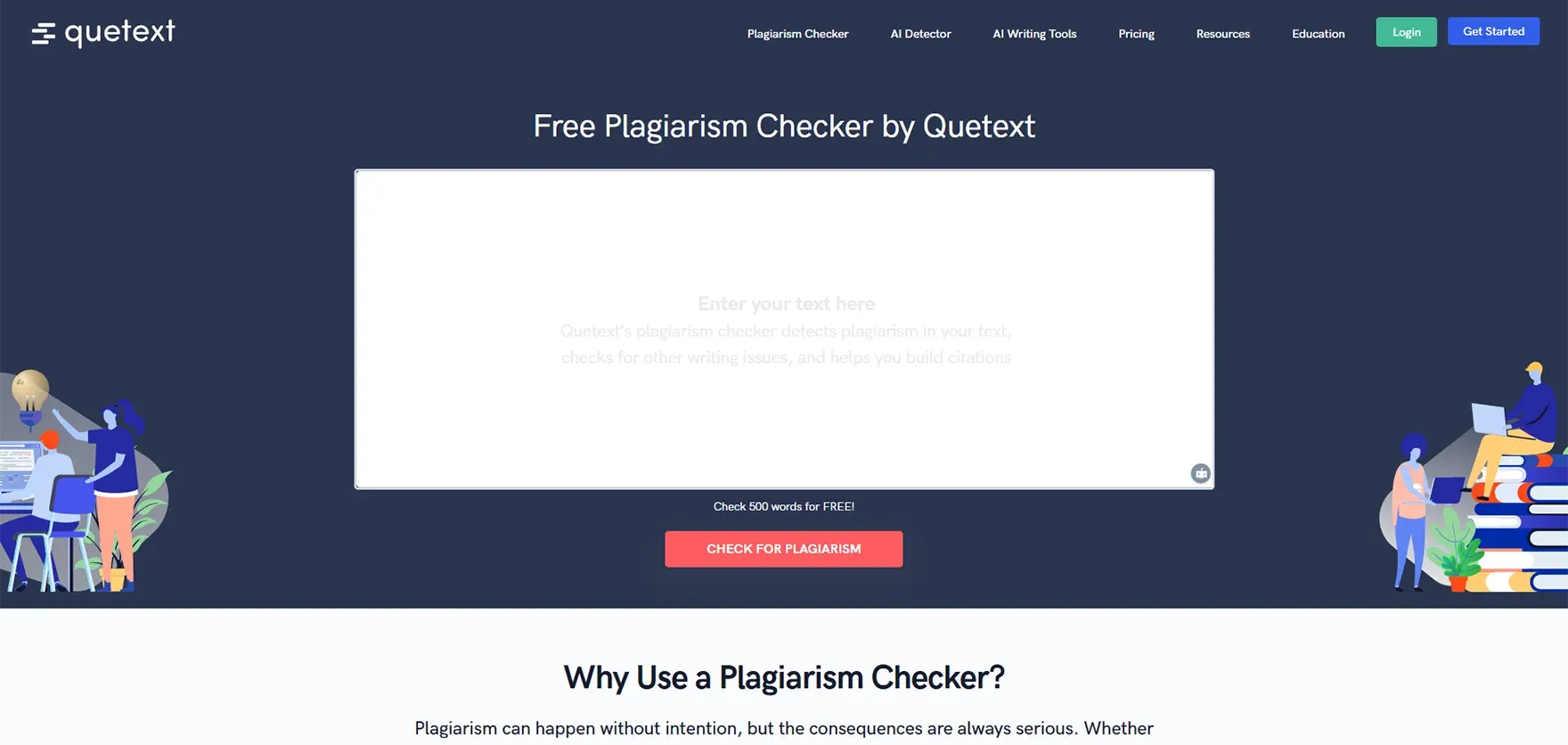
Pros
Easy-to-understand visual feedback
Strong detection for short- to mid-length content
Helpful for editorial teams and individual bloggers
Cons
The free plan has scan limits
Lacks multi-language support and academic databases
Ideal User: Independent authors, marketing teams, journalism students, writers, teachers, and content editors
Conclusion
Yes, if you want a quick plagiarism check for free online.
The SEO Tools Centre plagiarism checker is an excellent basic entry-level tool. It serves the basics relatively well and is best suited to freelance writers, bloggers, and students working on a tight budget. For anything critical, like publishing, academia, or corporate documentation, one should go for more advanced tools like Grammarly or Turnitin.
FAQs
1. Does the SEO Tools Centre plagiarism checker have a free version?
Yes, it has basic free usage. Paid features include document uploads.
2. How accurate is SEO Tools Center plagiarism checker?
Moderate accuracy. Use for basic checks; however, it cannot be considered 100% reliable for the academic or legal fields.
3. Am I allowed to upload files for a plagiarism check?
Yes, but only if you have a premium subscription.
4. Does the software store my content?
According to the site, it does not; however, it is always advisable to exercise caution with sensitive information.
5. Can the tool be used to detect AI-written content?
Not really. Directly speaking, it is about duplicate content from indexed websites.

